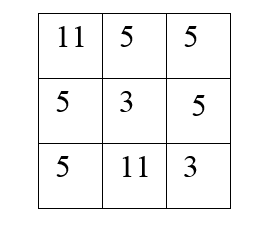Explanation
This question resembles a popular puzzle. The substance
here is non-algebraic here and naturally forks or prods us into analysis by
cases. Indeed, any puzzle of this nature is suited to analysis by cases,
because one unique case will prevail, while every other attractive-seeming case
will ultimately run into a disqualifying contradiction. Let's turn to the data
statements, separately first.
Statement (1) tells us that the upper-left and
bottom-center boxes of the table are each 11. Because of the non-repetition
rule of 11's, that actually means that
 , the square we are looking for, is the only other
square that could be 11, it's the only square outside a row or column of the
upper-left and bottom-center squares. So it could
be 11. That's Case I. But we can form a Case II in which it's not 11,
because the digit 5 may occur twice in a row or column, and that's a lot of
potential extra 5's. E.g.,
, the square we are looking for, is the only other
square that could be 11, it's the only square outside a row or column of the
upper-left and bottom-center squares. So it could
be 11. That's Case I. But we can form a Case II in which it's not 11,
because the digit 5 may occur twice in a row or column, and that's a lot of
potential extra 5's. E.g.,

So we have at least two possible values of
 , and hence we cannot answer the question definitively. Statement (1) is insufficient.
, and hence we cannot answer the question definitively. Statement (1) is insufficient.
Statement (2) tells us that a jumble of numbers multiplied
together gives us 375. All the numbers at hand are prime, so let's do a prime
factorization of 375. The general principle is that when you have multiplication
or division involving an integer with a large-ish
absolute value, you should consider using prime factorization. The number is
divisible by 375, so long division gives us

So this group, definitively, consists of one 3 and three
5's. So we are talking about the following shaded squares:

For most people, it would be wise to sketch this on the
note board, since the notation of the variables and subscripts on the screen is
prone to confusion. Our objective now, as is our objective generally when
analyzing by cases in Data Sufficiency, is to obtain cases that are both
allowed but yield different answers to the question, indicating insufficiency.
Our square of interest cannot be a 5, because, wherever we try to put the 5's
in the shaded squares, it would lead to three 5's in a row or column with the
shaded squares. It could easily be 11, since none of the numbers in its column
or row are 11's. So that's one case. The remaining question is whether it could
be 3, forming another case. We don't know what shaded square the 3 is in, but
regardless, putting a 3 in our square of interest would cause an illegal double
in the row or column along which the already existing 3 is. Therefore, there is
only one possible case, the square of interest must be an 11. We can answer the
question definitively, so we have sufficient information.
The correct answer is (B).
If you believe you have found an error in this question or explanation, please contact us and include the question title or URL in your message.